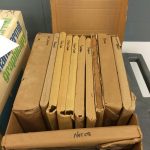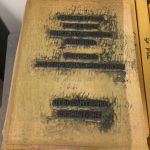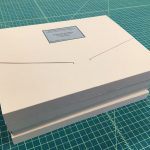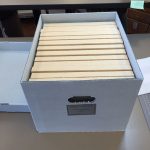
The Fred Turner Woodblock collection, prior to being displayed for the recent exhibition at the Archives Research Center, required the attention of the Conservation Lab at the University of Illinois. The woodblocks had previously been housed in degrading manila envelopes and cardboard boxes, which created an unhealthy environment for this important collection. There was also significant surface soil, wood dust, and insect debris throughout the collection. After receiving and examining the woodblocks, the University of Illinois conservation team chose to surface clean and rehouse them.

Four of the five woodblock boxes that were brought to conservation were outsourced to an outside company for cleaning. The fifth box was transferred later and surface cleaning treatment was performed in-house by the University of Illinois conservation team member Kasie Janssen. Surface cleaning for the woodblocks in the fifth box was achieved through the vacuuming of the items with a HEPA vacuum. Utilizing microtools, the small crevices of the woodblocks were cleaned, removing the surface soil, dust, and debris which had accumulated. Over the years of storage, this grime was able to work its way into the grain of the wood, making surface cleaning with the HEPA vacuum a priority.

Once all of the surface cleaning was completed, the next step taken was to rehouse each of the woodblocks. After conducting research into the best housing options for the woodblocks, the Conservation Unit made the decision that each woodblock would be housed in a custom-built tux box, which would then be stored upright in five new archival boxes. By housing each woodblock in a separate box, the transfer of printing ink which had dried on the blocks would be prevented.

As the previous enclosures for the woodblocks were discarded, labels were also made for each woodblock to display the relevant information about each block and its subject matter. The treatments preformed on the Fred Turner Woodblock Collection promote the long term preservation of and access to these woodblocks.
Return to Christmas 1971 | Continue to Acknowledgements
Fascinating! Had not heard of the Turner prints, but (serendipitously) had just happened on two handouts about them which were from the 2009 Champaign Co. Museum exhibit of the set of 29 prints donated to the museum in 1975.
Turner was a Dean under 7 UI presidents. One leaflet states the wood from which the print blocks are made had come from shelving in the Trustees’ Room of old University Hall, the second building on UI campus (1878). Turner bought the shelving from the contractor who handled the demolition. Nice work with the preservation storage!